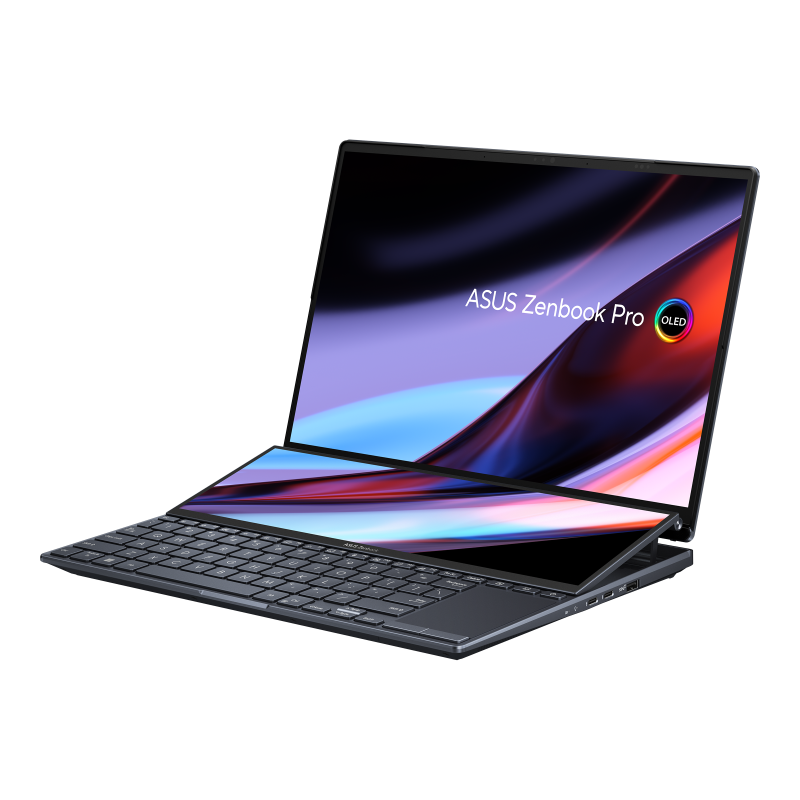When I was handed the Asus Zenbook Pro 14 Duo OLED for a review, I was taken aback by its elegant display, or should I say, displays! This ‘Duo’ laptop series by Asus comes with a secondary display sitting right above the keyboard for additional functionality. But is that all? Having a second display surely sets the product apart from the market but is it enough for users to jump on and grab it at the earliest? The answer is quite complicated!
We’re reviewing the maxed-out UX8402Z version of the laptop which houses the powerful Nvidia GeForce RTX3050Ti graphics card inside. This itself makes it one of the best gaming laptops in the market. It comes with Intel 12th gen i9 processor and a dynamic 32GB RAM coupled with 1TB SSD. In my usage of nearly two weeks, I did not face any issues with the laptop’s performance as one would expect with its impressive specifications. However, the drawing factor here is the displays which left me thinking if we’re already in the future!
You get two OLED screens here; a 14.5-inch 2.8K (2880 x 1800) display and a smaller 12.7-inch (2880 x 864) as the secondary display. Both of these screens are a treat to look at. Asus has not cut any corners when it comes to the displays as the primary screen comes with a refresh rate of 120Hz and a peak HDR brightness of 500 nits. Also, did I mention both the displays are touchscreen? The displays are simply vibrant, and crisp, and produce bright colors. A deal breaker for some could be the matte finish over the secondary display which honestly, felt aesthetic to me. The main 2.8K display is a stunner, watching content on this screen makes it an immersive experience thanks to the OLED display technology.
The smaller 12.7-inch screen is housed right above the keyboard and certainly has an impact on the laptop as the keyboard is pushed right into the front of it. The keyboard’s form factor has been minimized which requires some getting used to. Whereas, the touchpad and its associated buttons are pushed into the extreme right corner which does cause some accessibility issues. It is up to you to decide if this compromise is worth it for the secondary display. With the entire lower frame of the laptop used to the teeth with the secondary display and the keyboard, there is no space for you to rest your wrist. The laptop is equipped with physical buttons which allow you to quickly switch between the primary and the secondary screen, adding functionality.
Even though it sports dual screens, the Asus Zenbook Pro 14 Duo weighs only 1.75Kg, making it relatively thinner and lighter for a gaming-capable laptop. It comes with dark-blue refined magnesium-aluminum alloy chassis and a dimension of 323.5 x 224.7 x 19.6mm when shut close. The port selection is limited for a laptop in the premium segment. It comes with one USB 3.2 Gen 2 Type-A port, one HDMI 2.1 port, a memory card slot, two Thunderbolt 4 Type C ports, and finally, a 3.5mm headphone jack. The webcam placed right above the primary display has a 720P resolution. A laptop sleeve is also included in the box which is added delight!
Performance
I was sent the laptop with best-in-class specifications which proved to be more powerful than I need for my day-to-day tasks. I felt like Jim Carrey from Bruce Almighty just moments away from singing the ‘I Got The Power!’ song in my office. My daily line of work includes churning out research-based articles and scripts which do not require much processing power. I was expecting my chrome browsers to not lag at any given point and that’s what I got. However, I did install Marvel’s Spider-Man Remastered for PC to get a taste of gaming on this laptop, and as one would expect, it did not disappoint. The laptop handled the game like a champ giving high refresh rates consistently. The secondary display worked its charm as a music video screen while I was working on my daily tasks throughout the day. The touchscreen capabilities of both displays are a plus point! The battery life of this laptop is decent even with both displays on the entire time. I could get through my 8-hour shift easily with just one charge, however, the mileage may vary if you’re a heavy user.
The Asus Zenbook Pro 14 Duo OLED is no doubt a capable laptop, it has one of if not the best displays to offer in the market right now. But it is hard to recommend to everyone. If you’re a creator having a detailed eye for the color accuracy of your photos/videos, then this definitely is the laptop for you. This is a laptop for seasoned creators who know their way around Adobe’s apps like PhotoShop or Premiere Pro. If you’re an everyday user who browses the internet or streams YouTube/Netflix, there are ample options for you in the market!
Verdict
There is a novelty, then there is pricing! The maxed-out i9 version of this laptop which I used is priced at a whopping Rs 2,24,990. If you ask me, sure, the laptop is worth shelling out that much as it comes with multiple features which justify the pricing. But this might not be the case for everyone. If you’re not a heavy user, you can opt for the i5 variant of the laptop which is priced at Rs 1,44,990.
Good
- Vibrant Primary OLED screen
Bad
- No Wrist Support
Ugly
- Touchpad Placement
Rating – 4/5
Asus Zenbook Pro 14 Duo OLED Specifications:
- 14.5-inch 2.8K OLED display
- Intel 12th Gen i9 processor with Nvidia RTX3050Ti
- 32GB RAM
- 1TB PCIe SSD
- Windows 11
